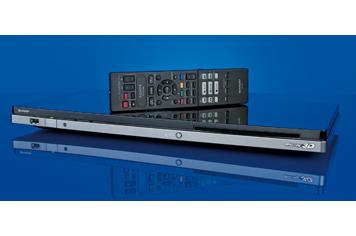What Hi-Fi? Verdict
Sharp deserves applause for thinking outside the box – with a few finishing touches this would be right at the top
Pros
- +
Unique looks and positioning options
- +
built-in wi-fi
- +
very capable performance from all types of disc
Cons
- -
The best perform even better
- -
slot-loading mechanism sounds like it’s struggling
- -
no online services
Why you can trust What Hi-Fi?
The BD-HP90S, Sharp's first 3D model, is just 36mm tall. That's if you choose to go all traditional and lie it flat, rather than use the included pedestal to stand it upright next to your telly.
This is such a slim piece of kit, though, that you might very well decide to go the whole designer hog and wall-mount it.
There is built-in wi-fi, which, like the ethernet connection, can be used to download new firmware from the internet and access DivX and DivX HD files from another computer or a network attached storage device on your own network. However, there are no internet services available.
Lack of display causes problems
One sacrifice in the name of slimness is the display: the unit has none.
Anyone who's been distracted by the bright lights of a player positioned near to the telly may well be pleased to hear that, but it does mean that even when you're playing a CD you're going to need to have your TV on in order to see what you're doing to change tracks.
Which leads us neatly on to sound quality, the area of performance that is quickly turning out to be the most variable for many Blu-ray players currently available.
The Sharp essentially gets a lot of things right. It avoids fluffiness in the bass and brightness in the treble, but it also lacks the real get up and go that's needed to translate the full energy of the Foo Fighters Live at Wembley Stadium Blu-ray, and the dynamic agility to convey fully the tension as the Orc army advances through the cavernous halls of Khazad-dum in The Fellowship of the Ring.
The picture of the new Blu-ray version of the first Lord of the Rings film does look great on the Sharp, though.
We're a little weary of saying this, but the picture isn't quite as pin-sharp as the very best; it is, however, detailed and solid by the standards of the market as a whole. It's also vibrant but natural in its colours, and it produces blacks that are both deep and insightful.
A little more noise
Switch to the DVD of the awesome Scott Pilgrim vs. The World, and, while the HP90S displays a little more noise than close rivals, it also digs-up more detail than most and offers up convincing colours
and realistic skin tones.
Finally switching to Coraline in 3D, the Sharp's vibrancy, detail and black depth all help create a very capable and enjoyable picture.
Some players produce edges that are a little sharper and less shimmery, but none is perfect and the Sharp is undeniably impressive.
It's not the very best, though, and it is the most expensive. Still, if you want to buy it for the looks, you can at least rest easy knowing you're also buying a solid performer.
See all our Blu-ray player Best Buys
What Hi-Fi?, founded in 1976, is the world's leading independent guide to buying and owning hi-fi and home entertainment products. Our comprehensive tests help you buy the very best for your money, with our advice sections giving you step-by-step information on how to get even more from your music and movies. Everything is tested by our dedicated team of in-house reviewers in our custom-built test rooms in London, Reading and Bath. Our coveted five-star rating and Awards are recognised all over the world as the ultimate seal of approval, so you can buy with absolute confidence.


